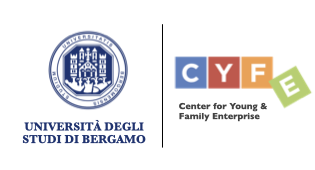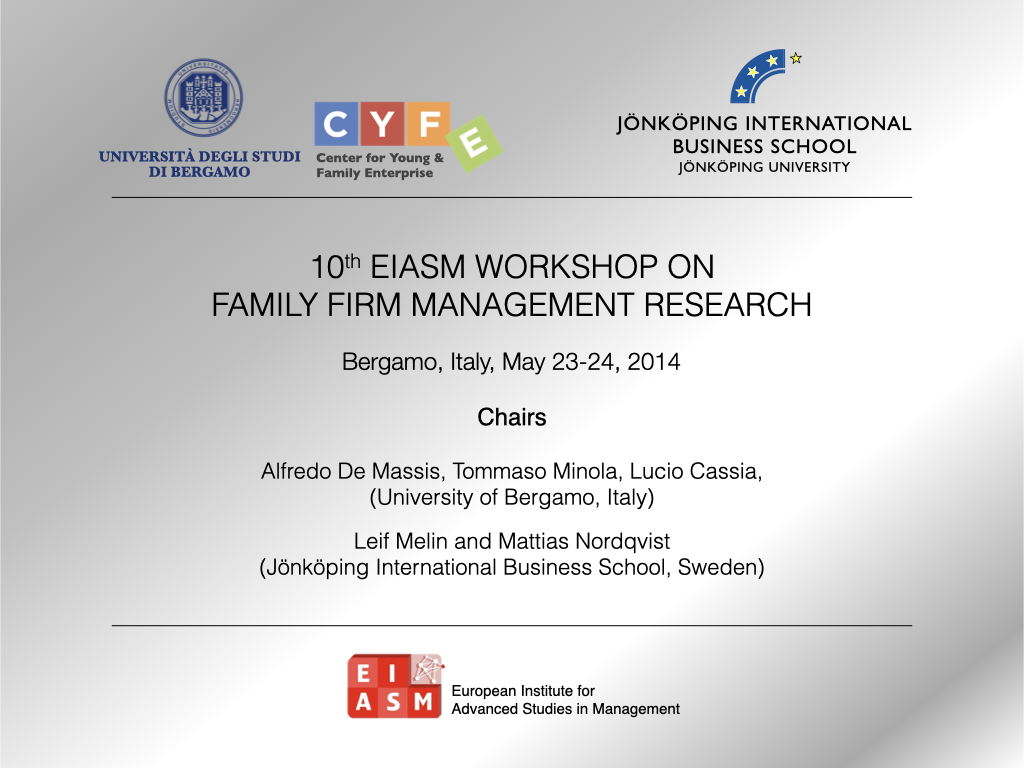10th EIASM Workshop on Family Firm Management Research
Bergamo, Italy – May 23-24, 2014
Innovation, Family Firms, and Economic Development
Chairs
Alfredo De Massis, Tommaso Minola, and Lucio Cassia
CYFE, University of Bergamo, Italy
Leif Melin and Mattias Nordqvist
CeFEO, Jönköping International Business School, Sweden
Keynote Speakers
David Audretsch
Indiana University, USA
Kimberly Eddleston
D'Amore-McKim School of Business, Northeastern University, USA

Co-organizer
CYFE – Center for Young and Family Enterprise
University of Bergamo, Italy
Call for papers
Family business research is progressing in terms of theory building and theory testing, and innovation in family firms has become a topic of increasing interest in management research in recent years (De Massis, Sharma, Chua, & Chrisman, 2012).
Research indicates that innovative companies do better than their competitors (Davidsson et al., 2010; Thornhill, 2006). This explains why innovation has been the subject of extensive theoretical and empirical studies and is now widely acknowledged as an important determinant of sustained competitive performance and economic development (Van Beers et al., 2008; Zahra et al., 1999). Together with technological and organizational innovation, internationalization is a further means to innovate a business by expanding the business activity to new geographical markets.
Family firms increasingly make use of innovation to nurture their competitive advantage and to overcome economic downturn (De Massis, Frattini, Pizzurno and Cassia, 2014), and the companies Alessi, Benetton and FIAT are just three examples of well-known family firms that have strongly anchored their competitive advantage in innovation.
The study of innovation in family firms is a promising research direction since strong theoretical reasons suggest that the antecedents and outcomes of innovation are different in family and nonfamily firms (Chrisman and Patel, 2012; De Massis, Frattini and Lichtenthaler, 2013). Ownership structure affects the firm’s innovation activities and outcomes (Hoskisson, Hitt, Johnson, and Grossman, 2002) through different level of firms’ risk aversion, diversification plans, and return aspirations (Thomsen and Pedersen, 2000). Moreover, family involvement in ownership, management, and governance can result in resources unique to the family firm (Habbershon & Williams, 1999), that can then be leveraged in ways that may influence the management of innovation. In sum, family firms play an important role in the innovation driven economic development.
During the 10th EIASM Workshop on Family Firm Management we want to encourage scholars to address the family business innovation from new and creative perspectives, including:
- how and why do family businesses innovate and what are appropriate ways to conceptualize and understand their innovation performance,
- family-centered goals and their effect on innovation inputs, processes and activities,
- how family firms’ ability to generate and manage idiosyncratic resources over time influences their degree of exploration and exploitation in the innovation process,
- the role of different types of family influence (ownership, management, control) in the different phases of the innovation process,
- how enterprising families become sources of new streams of value through new products, new ventures and new markets entry, as well as discontinuous organizational configurations,
- how family businesses contribute through unique social capital to the transfer of knowledge, collaboration, and the development of innovation systems,
- the temporal evolution of family firms innovativeness: when do family firms undertake innovative actions, with respect to internal (e.g., succession) and external (e.g., downturn or market saturation) factors.
While submission of papers related to the main theme - Innovation, family firms and economic development - are particularly encouraged, the workshop continues its tradition to accept papers relevant to any area of family firm management and which add value to the development of the family business research field.
Read more here.


